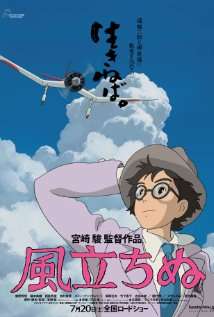 An romantic animated biopic of a Japanese warplane inventor
An romantic animated biopic of a Japanese warplane inventorThe great Japanese animator Hayao Miyazaki’s new film, his swan song, is based on the life of Jiro Hirokoshi, the man who designed the Zero fighter. This is a biopic, and one that may have an odd ring to it in part for American viewers who recall that the fighter planes built by Mitsubishi were used to fight against the Allied forces World War II against Pearl Harbor and in kamikaze operations. Hence this film seems unlikely to win a US audience as did films like
Princess Mononoke (1997),
Spirited Away (2001), and
Howl's Moving Castle (2004) -- at least if anyone remembers as far back as the Second World War.
The story begins with a little boy -- Jiro Hirokoshi -- who dreams of flying planes, and as a young man heroically saves a young woman who breaks her leg after an earthquake that derails a train and causes cities to catch fire -- this is the 1923 earthquake followed by a firestorm and typhoon that devastated Tokyo and Yokohama. The girl Jiro meets is Nahoko, who is to become his love. This is a story for boys, with a romantic hook for girls to catch onto. Jiro grows up to become a talented aeronautical engineer focused on making planes lighter and stronger. When he entered the field, the Germans had metal planes; the Japanese ones were of wood and fell apart at high speeds or in high winds.
Miyazaki and his team are as good as ever at gracefully imagining whatever they want, as we see in the striking yet understated recreation of the earthquake destroying trains and houses early on, and what Scott Foundas in his hype-worthy
Variety review calls "flights of incredible visual fancy, harrowing images of poverty and destruction, and touches of swooning romance." Foundas is not only
Variety's current chief critic but on the selection committee of the New York Film Festival, which has chosen to include this between-two-wars aviation story as part of its Main Slate. Given that this is by Miyazaki and is reportedly his last work, this is an understandable ceremonial choice for a film festival. And I loved the beauty and lightness of the images here. However, there's no getting away from how conventional a story this is, and how mediocre, even, it would be likely to seem if the same material were all filmed as an ordinary feature with live actors and real settings. But, of course, the medium is the message. It is a pleasure to see relatively old fashioned animated images with a hint of a drawn linear quality rather than the stuffed plastic doll effects of 3D Pixar films and all the horrid American imitations that unceasingly follow in their wake.
The film is best at capturing a sense of childish imagination, and it makes sense that it delivers several of Jiro's flying dreams early on. After those, the aerial travel sequences read at least in part like dreams -- a quality it would be hard to convey in a regular feature film. On the other hand, for even a boy interested in the aeronautical engineering part of the story, this account lacks detail. The engineering drawings in Jiro's shop look like animator's sketches, not the real thing. The early Japanese planes, which would have been no doubt impossible to recreate, as would the elaborate creations of Jiro's early inspiration the Italian aviation pioneer Giovanni Caproni, also have a dreamlike quality that is appealing, if also perhaps a bit trivializing of the actual historical events. In Miyazai's reimagining of events, Caprioni and Hirokoshi actually share aviation dreams.
Hirokoshi is one of the Japanese engineers who go to see the Germans, whose superior plane they want to buy and bring back to copy (this may sound vaguely familiar). The actual war is not shown. Instead there is simply an image of vapor trains futilely foundering above dark cloud masses with a kind of cemetery below them of falled fragments of planes. And Jiro simply declares, "Not a single plane came back. That's what it means to lose a war." Perhaps this straightforward declaration will keep the film from being offensive to audiences from Japan's former opponents in the war. Or it may make the film ultimately feel vaguely irrelevant.
The film loses its momentum and its aviation focus in the second half when Jiro meets Nahoko again, now a victim of the TB epidemic, at a mountain resort that Miyazaki links to Thomas Mann's "Magic Mounntain." A structural problem? The title comes from a famous line from the French poet Paul Valéry that Jiro and Nahoo inexplicably if charmingly exchange when the first meet on that ill-starred train, "Le vent se lève, il faut tenter de vivre," "The wind is rising, one must try to live." The drawing, especially of the young man Jiro, sometimes evokes the style of Fifties French children's books. It's been pointed out that Miyazaki dealt with early aviation in his 1992 film
Porco Rosso.
The Wind Rises, 126 mins., debuted at Venice and was screened for this review as part of the New York Film Festival at Lincoln Center, Sept. 2013. US Oscar-qualifying release in Nov., and again in wider (limited) release Feb. 21 2014.





